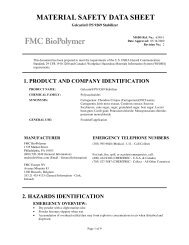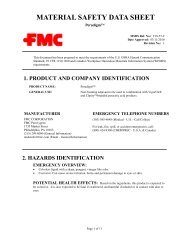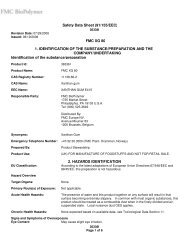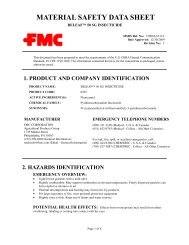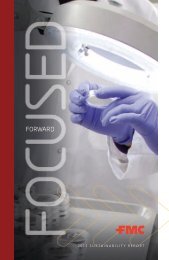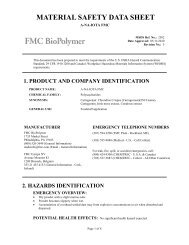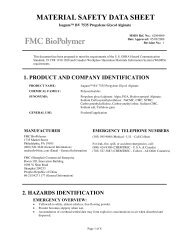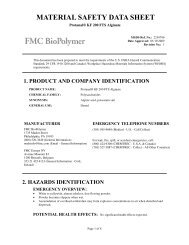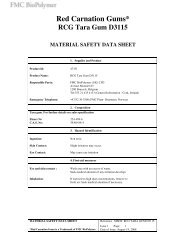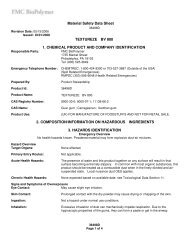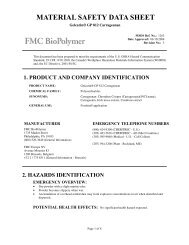PROTANAL® BK 1454 Alginate Blend - FMC Corporation
PROTANAL® BK 1454 Alginate Blend - FMC Corporation
PROTANAL® BK 1454 Alginate Blend - FMC Corporation
You also want an ePaper? Increase the reach of your titles
YUMPU automatically turns print PDFs into web optimized ePapers that Google loves.
MATERIAL SAFETY DATA SHEET<br />
<strong>PROTANAL®</strong> <strong>BK</strong> <strong>1454</strong> <strong>Alginate</strong> <strong>Blend</strong><br />
Page 1 of 10<br />
MSDS Ref. No.: 2270201<br />
Date Approved: 06/17/2010<br />
Revision No.: 1<br />
This document has been prepared to meet the requirements of the U.S. OSHA Hazard Communication<br />
Standard, 29 CFR 1910.1200 and Canada’s Workplace Hazardous Materials Information System (WHMIS)<br />
requirements.<br />
1. PRODUCT AND COMPANY IDENTIFICATION<br />
PRODUCT NAME: <strong>PROTANAL®</strong> <strong>BK</strong> <strong>1454</strong> <strong>Alginate</strong> <strong>Blend</strong><br />
CHEMICAL FAMILY: Polysaccharides<br />
SYNONYMS: Calcium sulfate, dihydrate: Terra alba, gypsum, native calcium<br />
sulfate; Sucrose: Saccharose, cane sugar, sugar, granulated sugar,<br />
beet sugar; Sodium alginate: Algin (INCI name), alginic acid,<br />
sodium salt; Tetrasodium pyrophosphate: Tetrasodium<br />
pyrophosphate (INCI name): TSPP, sodium pyrophosphate,<br />
tetrasodium diphosphate; Disodium phosphate: DSP, DSOP,<br />
Disodium Orthophosphate, Disodium monohydrogen phosphate,<br />
Disodium hydrogen phosphate, Sodium hydrogen phosphate<br />
GENERAL USE: Foodstuff application<br />
MANUFACTURER<br />
<strong>FMC</strong> BioPolymer<br />
1735 Market Street<br />
Philadelphia, PA 19103<br />
(800) 526-3649 (General Information)<br />
msdsinfo@fmc.com (Email - General Information)<br />
<strong>FMC</strong> Europe NV<br />
Avenue Mounier 83<br />
1200 Brussels, Belgium<br />
353 21 435 4133 (General Information - Cork,<br />
Ireland)<br />
EMERGENCY TELEPHONE NUMBERS<br />
+44 1655 333000 (Plant - Girvan, Scotland)<br />
(303) 595-9048 (Medical - U.S. - Call Collect)<br />
For leak, fire, spill, or accident emergencies, call:<br />
(800) 424-9300 (CHEMTREC - U.S.A. & Canada)<br />
(703) 527-3887 (CHEMTREC - Collect - All Other Countries)
<strong>PROTANAL®</strong> <strong>BK</strong> <strong>1454</strong> <strong>Alginate</strong> <strong>Blend</strong> (2270201) Date: 06/17/2010<br />
2. HAZARDS IDENTIFICATION<br />
EMERGENCY OVERVIEW:<br />
• White to yellowish-brown, almost odorless, free-flowing powder.<br />
• Accumulation of overhead settled dust may form explosive concentrations in air when disturbed and<br />
dispersed.<br />
• Powder becomes slippery when wet.<br />
• Not expected to be toxic to the environment, nor to aquatic organisms.<br />
POTENTIAL HEALTH EFFECTS: Severely irritating to the eyes.<br />
3. COMPOSITION / INFORMATION ON INGREDIENTS<br />
Chemical Name CAS# Wt.% EC No. EC Class<br />
Disodium phosphate 7558-79-4 231-448-7 Not classified<br />
Tetrasodium Pyrophosphate 7722-88-5 231-767-1 Not classified<br />
Sodium alginate 9005-38-3 232-680-1 Not classified<br />
Calcium Sulfate, dihydrate 10101-41-4 None Not classified<br />
Sucrose 57-50-1 200-334-9 Not classified<br />
4. FIRST AID MEASURES<br />
EYES: Immediately flush with water for at least 15 minutes, lifting the upper and lower eyelids<br />
intermittently. See a medical doctor or ophthalmologist immediately.<br />
SKIN: Wash with plenty of soap and water. Get medical attention if irritation occurs and persists.<br />
INGESTION: Drink 1 or 2 glasses of water. Never give anything by mouth to an unconscious<br />
person. If any discomfort persists, obtain medical attention.<br />
INHALATION: Remove to fresh air. If breathing difficulty or discomfort occurs and persists, obtain<br />
medical attention.<br />
NOTES TO MEDICAL DOCTOR: This product is expected to have low oral, dermal and<br />
inhalation toxicity. It is expected to be severely irritating to the eyes, and non-irritating to the skin. It is<br />
expected to be irritating to the respiratory tract and mucous membranes. Aspiration or inhalation of<br />
alginates could cause chemical pneumonitis. Ingestion of TSPP may be associated with nausea or vomiting,<br />
Page 2 of 10
<strong>PROTANAL®</strong> <strong>BK</strong> <strong>1454</strong> <strong>Alginate</strong> <strong>Blend</strong> (2270201) Date: 06/17/2010<br />
salivation, diarrhea, occasional abdominal discomfort and intestinal distention. Large doses of phosphates<br />
are laxatives. Treatment is symptomatic and supportive.<br />
5. FIRE FIGHTING MEASURES<br />
EXTINGUISHING MEDIA: Water, foam, dry chemical, CO2<br />
FIRE / EXPLOSION HAZARDS: As with most organic materials, excessive accumulation<br />
of dust on overhead structures may produce explosive concentrations when disturbed and dispersed by a<br />
small explosion that shakes down accumulated dust and causes, momentarily, an ignitable concentration.<br />
Product will burn when in contact with a flame, but self-extinguishes when ignition source is removed.<br />
FIRE FIGHTING PROCEDURES: None. Treat as ''Class A'' fire. Once ignited, the<br />
product tends to smolder.<br />
FLAMMABLE LIMITS: Not applicable<br />
6. ACCIDENTAL RELEASE MEASURES<br />
RELEASE NOTES: Powder becomes slippery when wet. Maintain good housekeeping practices<br />
to minimize accumulation of settled dust, especially on overhead surfaces. Sweep up the spilled material<br />
and dispose of in accordance with the waste disposal method outlined in Section 13, "Disposal<br />
Considerations" below. Refer to Section 8 "Exposure Controls / Personal Protection" for appropriate<br />
personal protective equipment.<br />
7. HANDLING AND STORAGE<br />
HANDLING AND STORAGE: Use local exhaust or general dilution ventilation to control<br />
exposure to dust. Always use safe lifting techniques when manually moving containers, especially when<br />
handling containers weighing more than 50 pounds (22.7 kg). To protect quality, store in a tight container<br />
in a dry place. Avoid exposure to excessive heat. Keep material out of lakes, streams, ponds and sewer<br />
drains.<br />
Page 3 of 10
<strong>PROTANAL®</strong> <strong>BK</strong> <strong>1454</strong> <strong>Alginate</strong> <strong>Blend</strong> (2270201) Date: 06/17/2010<br />
8. EXPOSURE CONTROLS / PERSONAL PROTECTION<br />
EXPOSURE LIMITS<br />
Chemical Name ACGIH OSHA Supplier<br />
Calcium Sulfate,<br />
dihydrate<br />
Sucrose<br />
10 mg/m 3 (TWA)<br />
(inhalable fraction)<br />
10 mg/m 3 (TWA)<br />
Page 4 of 10<br />
15 mg/m 3 (PEL) (total<br />
dust)<br />
5 mg/m 3 (PEL)<br />
(respirable dust)<br />
15 mg/m 3 (PEL) (total<br />
dust)<br />
5 mg/m 3 (PEL)<br />
(respirable dust)<br />
ENGINEERING CONTROLS: Use local exhaust, which is sufficient enough to remove<br />
airborne dust.<br />
PERSONAL PROTECTIVE EQUIPMENT<br />
EYES AND FACE: Whenever airborne dust concentrations are high, appropriate<br />
protective eyewear, such as mono-goggles, should be worn to prevent eye contact.<br />
RESPIRATORY: Whenever dust, in the worker's breathing zone, cannot be controlled<br />
with ventilation or other engineering means, workers should wear respirators or dust masks<br />
approved by NIOSH/MSHA, EU CEN or comparable certification organization to protect them<br />
against airborne dust.<br />
PROTECTIVE CLOTHING: No special clothing is required; however, all work<br />
clothing should be laundered before reuse.<br />
GLOVES: No special gloves are required; however, if gloves are worn, the outside of the<br />
gloves should be washed thoroughly with soap and water after use.<br />
9. PHYSICAL AND CHEMICAL PROPERTIES<br />
ODOR: Almost odorless<br />
APPEARANCE: White to yellowish-brown, free-flowing powder<br />
AUTOIGNITION TEMPERATURE: > 200 °C (> 392 °F)<br />
BOILING POINT: None volatile<br />
EVAPORATION RATE: Not applicable (Butyl Acetate = 1)<br />
FLASH POINT: Not applicable
<strong>PROTANAL®</strong> <strong>BK</strong> <strong>1454</strong> <strong>Alginate</strong> <strong>Blend</strong> (2270201) Date: 06/17/2010<br />
MELTING POINT: Not available<br />
PERCENT VOLATILE: Not available<br />
pH: 6.2 - 8.2 (1% aqueous solution)<br />
SOLUBILITY IN WATER: Slowly soluble, forming a viscous, colloidal solution<br />
VAPOR DENSITY: Not available<br />
VAPOR PRESSURE: Not available<br />
COMMENTS:<br />
EXPLOSIVE PROPERTIES: Not applicable<br />
10. STABILITY AND REACTIVITY<br />
CONDITIONS TO AVOID: Strong oxidizing agents, high temperatures and<br />
high humidity levels.<br />
STABILITY: Stable<br />
POLYMERIZATION: Will not occur<br />
HAZARDOUS DECOMPOSITION PRODUCTS: None known<br />
11. TOXICOLOGICAL INFORMATION<br />
EYE EFFECTS: No data available for the formulation.<br />
Sodium alginate: Non-irritating (rabbit)<br />
DSP: Mildly irritating (500 mg/24 hr)<br />
TSPP: Extremely irritating (rabbit) Unwashed eyes<br />
TSPP: Minimally irritating (rabbit) Washed eyes<br />
SKIN EFFECTS: No data available for the formulation.<br />
Sodium alginate: Non-irritating (rabbit)<br />
DSP: Mildly irritating (500 mg/24 hr., Draize test)<br />
TSPP: Non-irritating (rabbit)<br />
Sucrose: Non-irritating (rabbit)<br />
DERMAL LD50: No data available for the formulation.<br />
TSPP: > 2,000 mg/kg (rabbit)<br />
ORAL LD50: No data available for the formulation.<br />
Sodium alginate: > 5,000 mg/kg (rat)<br />
DSP: 1,700 mg/kg (rat)<br />
TSPP: 4,000 mg/kg (rat)<br />
Sucrose: 29.7 g/kg (rat)<br />
Page 5 of 10
<strong>PROTANAL®</strong> <strong>BK</strong> <strong>1454</strong> <strong>Alginate</strong> <strong>Blend</strong> (2270201) Date: 06/17/2010<br />
INHALATION LC50: No data available for the formulation.<br />
Sodium alginate: 4.72 mg/l (1 h) (rat)<br />
SENSITIZATION: No data available for the formulation.<br />
Sodium alginate: Non-sensitizing (guinea pig)<br />
ACUTE EFFECTS FROM OVEREXPOSURE: This product is expected to have low<br />
oral, dermal and inhalation toxicity. It is expected to be severely irritating to the eyes and mildly irritating<br />
to the skin. It is expected to be irritating to the respiratory tract and mucous membranes. Ingestion of large<br />
quantities of alginates may cause intestinal obstruction. Aspiration or inhalation could cause chemical<br />
pneumonitis. Ingestion of TSPP may be associated with nausea or vomiting, salivation, diarrhea, occasional<br />
abdominal discomfort and intestinal distention. Phosphates are laxatives.<br />
CHRONIC EFFECTS FROM OVEREXPOSURE: No data available for the<br />
formulation. Sodium alginate showed no adverse effects in chronic studies when administered in the diet (5<br />
- 15%). It is classified as safe and non-toxic. The Joint WHO/FAO Expert Committee on Food Additives<br />
(JECFA) has granted an Acceptable Daily Intake (ADI) of "not specified" (no upper limit), the best<br />
possible classification for food additives (JECFA, 39th session of 23/12 February 1992). TSPP was<br />
negative in the Ames assay. Excessive sub-chronic exposure to high levels of TSPP has been shown to<br />
cause kidney damage in laboratory animals. Sucrose is not carcinogenic and tested negative in a variety of<br />
in vitro mutagenicity assays. Some animal teratogenicity studies at high doses of sucrose have shown<br />
adverse effects on the fetus, possible due to uncontrolled glucose concentrations in maternal blood.<br />
CARCINOGENICITY:<br />
NTP: Not listed<br />
IARC: Not listed<br />
OSHA: Not listed<br />
OTHER: Not Listed (ACGIH)<br />
12. ECOLOGICAL INFORMATION<br />
ENVIRONMENTAL DATA: No data available for the formulation. Inorganic compounds in<br />
contact with the soil, sub-surface or surface waters may be taken up by plants and utilized as essential<br />
nutrients. Phosphates may also form precipitates, usually with calcium or magnesium. The resultant<br />
compounds are insoluble in water and become a part of the soil or sediment. The term biodegradability, as<br />
such, is not applicable to inorganic compounds.<br />
ECOTOXICOLOGICAL INFORMATION:<br />
No data available for the formulation. Sodium alginate is biodegradable.<br />
DSP:<br />
96-hour LC50 > 100 mg/L (non-toxic) (mysid shrimp, menidia, rainbow trout) (low toxicity)<br />
48-hour EC50 > 100 mg/L (non-toxic) (daphnia) (low toxicity)<br />
TSPP:<br />
96-hour LC50 > 100 mg/L (non-toxic) (rainbow trout, inland silversides, mysid shrimp) (low toxicity)<br />
Page 6 of 10
<strong>PROTANAL®</strong> <strong>BK</strong> <strong>1454</strong> <strong>Alginate</strong> <strong>Blend</strong> (2270201) Date: 06/17/2010<br />
48-hour EC50 > 100 mg/L (non-toxic) (daphnia magna) (low toxicity)<br />
13. DISPOSAL CONSIDERATIONS<br />
DISPOSAL METHOD: No special disposal methods are suggested. It is the user's responsibility<br />
to comply with all applicable local, state, and federal laws, rules, regulations and standards.<br />
14. TRANSPORT INFORMATION<br />
U.S. DEPARTMENT OF TRANSPORTATION (DOT)<br />
PACKAGING TYPE: Non-Bulk<br />
ADDITIONAL INFORMATION: This material is not regulated in<br />
transportation.<br />
PACKAGING TYPE: Bulk<br />
PROPER SHIPPING NAME: Environmentally hazardous substance,<br />
liquid, n.o.s.<br />
TECHNICAL NAME(S): Disodium phosphate<br />
PRIMARY HAZARD CLASS / DIVISION: 9<br />
PACKING GROUP: III<br />
ADDITIONAL INFORMATION: This material is not regulated as a hazardous<br />
material when packaged in quantities less<br />
than 19230 pounds per 49 CFR<br />
§173.150(f)(2).<br />
INTERNATIONAL MARITIME DANGEROUS GOODS (IMDG)<br />
ADDITIONAL INFORMATION: Not regulated as a hazardous material<br />
ADR - EUROPEAN AGREEMENT CONCERNING THE<br />
INTERNATIONAL CARRIAGE OF DANGEROUS GOODS BY ROAD<br />
ADDITIONAL INFORMATION: Not regulated as a hazardous material<br />
Page 7 of 10
<strong>PROTANAL®</strong> <strong>BK</strong> <strong>1454</strong> <strong>Alginate</strong> <strong>Blend</strong> (2270201) Date: 06/17/2010<br />
INTERNATIONAL CIVIL AVIATION ORGANIZATION (ICAO) /<br />
INTERNATIONAL AIR TRANSPORT ASSOCIATION (IATA)<br />
ADDITIONAL INFORMATION: Not regulated as a hazardous material<br />
OTHER INFORMATION:<br />
CANADIAN TRANSPORT (TDG):<br />
This material is not regulated when transported by road in Canada.<br />
15. REGULATORY INFORMATION<br />
UNITED STATES<br />
SARA TITLE III (SUPERFUND AMENDMENTS AND REAUTHORIZATION ACT)<br />
SECTION 302 EXTREMELY HAZARDOUS SUBSTANCES (40 CFR 355, APPENDIX A):<br />
Not listed<br />
SECTION 311 HAZARD CATEGORIES (40 CFR 370):<br />
Not applicable<br />
SECTION 312 THRESHOLD PLANNING QUANTITY (40 CFR 370):<br />
The Threshold Planning Quantity (TPQ) for this product, if treated as a mixture, is 10,000 lbs;<br />
however, this product contains the following ingredients with a TPQ of less than 10,000 lbs.:<br />
Not listed<br />
SECTION 313 REPORTABLE INGREDIENTS (40 CFR 372):<br />
This product does not contain any toxic chemicals subject to the reporting requirements of<br />
Section 313, Title III of the SARA (Superfund Amendments and Reauthorization Act) of<br />
1986.<br />
CERCLA (COMPREHENSIVE ENVIRONMENTAL RESPONSE COMPENSATION AND<br />
LIABILITY ACT)<br />
CERCLA DESIGNATION & REPORTABLE QUANTITIES (RQ) (40 CFR 302.4):<br />
Listed<br />
Chemical Name RQ<br />
Disodium phosphate 5,000 lb<br />
TSCA (TOXIC SUBSTANCE CONTROL ACT)<br />
TSCA INVENTORY STATUS (40 CFR 710):<br />
All components are listed or exempt.<br />
Page 8 of 10
<strong>PROTANAL®</strong> <strong>BK</strong> <strong>1454</strong> <strong>Alginate</strong> <strong>Blend</strong> (2270201) Date: 06/17/2010<br />
CANADA<br />
WHMIS (WORKPLACE HAZARDOUS MATERIALS INFORMATION SYSTEM):<br />
Hazard Classification / Division: D2B<br />
Domestic Substance List: All components are listed or exempt.<br />
E NUMBERS:<br />
E 401 (sodium alginate)<br />
INTERNATIONAL LISTINGS<br />
Calcium sulfate, dihydrate<br />
Australia (AICS): Listed<br />
China: Listed<br />
Philippines (PICCS): Listed<br />
Japan (ENCS): (1)-193<br />
New Zealand: Listed<br />
Sucrose<br />
Australia (AICS): Listed<br />
Korea: KE-17258<br />
Philippines (PICCS): Listed<br />
China: Listed<br />
New Zealand: Listed<br />
Sodium alginate<br />
Australia (AICS): Listed<br />
Korea: KE-00492<br />
Japan (ENCS): (8)-237<br />
Philippines (PICCS): Listed<br />
China: Listed<br />
New Zealand: Listed<br />
Tetrasodium pyrophosphate<br />
Australia (AICS): Listed<br />
Korea: KE-33702<br />
Japan (ENCS): (1)-497<br />
Philippines (PICCS): Listed<br />
China: Listed<br />
New Zealand: Listed<br />
Disodium phosphate<br />
Australia (AICS): Listed<br />
Korea: KE-12344<br />
Japan (ENCS): (1)-497<br />
Philippines (PICCS): Listed<br />
China: Listed<br />
New Zealand: Listed<br />
HAZARD AND RISK PHRASE DESCRIPTIONS:<br />
EC Symbols: (Not classified as hazardous)<br />
Page 9 of 10
<strong>PROTANAL®</strong> <strong>BK</strong> <strong>1454</strong> <strong>Alginate</strong> <strong>Blend</strong> (2270201) Date: 06/17/2010<br />
EC Risk Phrases: (Not classified as hazardous)<br />
16. OTHER INFORMATION<br />
NFPA<br />
Health 2<br />
Flammability 1<br />
Reactivity 0<br />
Special None<br />
No special requirements<br />
NFPA (National Fire Protection Association)<br />
Degree of Hazard Code:<br />
4 = Extreme<br />
3 = High<br />
2 = Moderate<br />
1 = Slight<br />
0 = Insignificant<br />
REVISION SUMMARY:<br />
New MSDS.<br />
Protanal and <strong>FMC</strong> BioPolymer - Trademarks of <strong>FMC</strong> <strong>Corporation</strong><br />
© 2010 <strong>FMC</strong> <strong>Corporation</strong>. All Rights Reserved.<br />
Page 10 of 10



